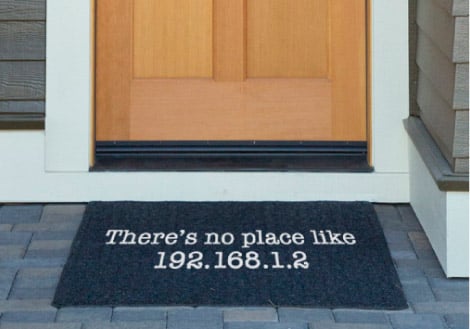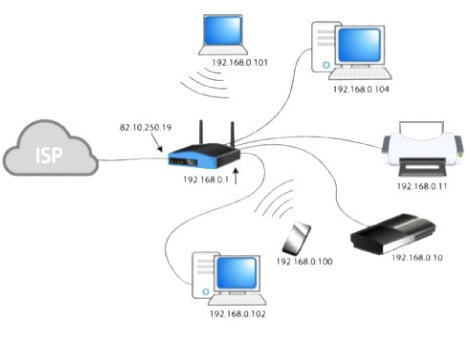What is Private IP Addresses: Understanding & Uses

If you were searching for information on an IP address such as 192.168.1.1 or 10.0.0.1, you’re most likely looking for a private IP address, not a public one. Because — and you may not realize this — you have both a public and a private IP address for your home network.
Sounds confusing — how can an IP address be both public and private? That’s what this guide is for.
This guide covers what private IP addresses are, the difference between public IP addresses and private ones, and how to find your home router’s public and private IP addresses.
Jump to the section you’re looking for:
- What’s a public IP address?
- What’s a private IP address?
- How private and public IP addresses work together
- Common default IP addresses for routers
- How to find your private IP address
- Find your private IP on Windows
- Find your private IP on Mac
- Find your private IP on iPhone or iPad
- Find your private IP on Android
- FAQs
What is a public IP address?
The IP address you see on our homepage — that looks like this: 24.156.99.202 — is an example of a public IP address. When you get a router for your home network, it’s the job of your internet service provider (ISP) to assign it a public IP address. This address can be accessed directly from the rest of the internet.
Think of it this way: having a public IP address is like having a P.O. box number instead of using your home address. It’s a little bit safer and keeps people from knowing your real address.
So, if you’ve ever wondered what a public IP address is, now you know. It’s that simple.
Now, about that other kind of IP address…
What is a private IP address?
Home routers have a public IP address, but the ISP also assigns a private IP address number. It’s also referred to as a local IP address. It’s usually the same address for the other models from that manufacturer, and it can be seen in the manufacturer’s documentation.
Who knew?
Your public IP address is the IP address that someone on the other end of your internet activity would see (should they bother to look for it). That’s the only reason it’s known as a public IP address.
With traditional snail mail, when you send a letter, you have to know the address to send it to — such as “1234 Main Street,” — so that the postal worker knows which street and house to take it to.
The internet works similarly, except it directs your personal activity (emails, answers to Google inquiries, etc.), and forwards the electronic messages to your computer’s IP address.
You couldn’t do much without a public IP address. It’s your passport to the internet.
[Insert youtube video: What is a Private IP Address? The Difference between Public IP & Private IP Addresses Explained ]
How private and public IP addresses work together
In theory, your computer must have its own unique IP address so that it will only receive the information that is meant for you.
However, that’s not how it works out because of one major exception — network computers that are linked to a router and share the same public IP address.
Remember: if you have a router, you have a private IP address.
And here’s how your router works…
The organizations that distribute IP addresses to the world reserve a range of IP addresses for private networks.
- 192.168.0.0 – 192.168.255.255 (65,536 IP addresses)
- 172.16.0.0 – 172.31.255.255 (1,048,576 IP addresses)
- 10.0.0.0 – 10.255.255.255 (16,777,216 IP addresses)
Your simple home network, with its router at the center and computers connected to it — wired or wireless — counts as just one of those networks.
Once your router makes its internet connection through your internet service provider, it sends internet activity to any computer connected to your router and is the basis of a networking innovation called a Network Address Translation (NAT).
- NAT is a process in which your router translates your private IP address into a public one so that it can send your traffic over the internet, keeping track of the changes in the process.
- When the information comes back to your router, it reverses the change — from a public IP address into a private one — and forwards the traffic back to your computer.
Your private address is just for your router, your network, and you.
Each of the devices connected to your home network has a private IP that your router keeps track of for you. So when you hit search on amazon.com on your smartphone, it sends a request to your router, which pushes it out to the internet, and when the response comes (all in a fraction of a second), your router knows to send it to your smartphone and not your PS5.
Your network has a range of (private) IP addresses that your router can assign to your devices at a given time, as the devices connect or disconnect to the web. And this is fine: the private address ranges in a network don’t have to be synchronized with the rest of the world and the internet.
As a matter of fact, the private address range can be used by more than one router because they’re being used by a private network. Even if your neighbor is using the exact same addresses, it won’t cause a problem, because that’s their network, not yours.
Don’t let that confuse you.
These private addresses are known as non-routable addresses. The networking on the internet routes internet activity connected to your public IP address only, not your private IP. So there’s no chance that the data your neighbor requested from the internet will get to your network, even if their computer has the same private IP as your smartphone at the time.

Default router IP address list for common routers
Here’s a look at the default private (also called “local”) IP addresses for popular brands of routers:
- Linksys routers use 192.168.1.1
- D-Link and NETGEAR routers are set to 192.168.0.1
- Cisco routers use either 192.168.10.2, 192.168.1.254 or 192.168.1.1
- Belkin and SMC routers often use 192.168.2.1
How to find your private IP address
Finding a private IP address isn’t as easy as going to whatismyipaddress.com, but it’s still pretty straightforward. You can usually find it in your device or operating system settings. The steps vary slightly whether you’re on Windows, macOS, iPhone, or Android. We have instructions for how to find your private IP for each operating system below.
BTW: If you’re looking for the public IP address, that’s what Whatismyipaddress is for!
How to find the IP address of your router using Windows
To find your local IP address on a Windows machine, follow these steps:
- Click Start and then select Settings.
- Click Network & Internet.
- Click the button that says Properties.
- Scroll down until you see IPv4 address. This number is your local IP address.
To find it even more quickly on Windows, you can use the command prompt. Here’s how:
- Click Start then type cmd to open the Command Prompt window.
- Type ipconfig into the Command Prompt and press enter. You will see a list of addresses including your IPv4 address. This is your local IP address.
How to find the IP address of your router on a Mac
To find your private IP address on a Mac, follow these steps:
- Click on the Apple Menu.
- Click System Preferences.
- Click Network.
- Choose your network connection from the menu on the left.
- You will see your local IP address listed next to IP Address for Ethernet connections and underneath Status for Wi-Fi connections.
How to find the IP address of your router on iPhone or iPad
Here’s how to find your local IP address on an iPhone or iPad:
- Go to Settings.
- Tap Wi-Fi.
- Tap the information icon next to your Wi-Fi connection. Scroll until you see your IP address.
How to find the IP address of your router on Android
Find your local IP address on an Android device by following these steps:
- Go to Settings.
- Tap About Phone.
- Tap Status Information. You will see your IP address listed.
FAQs
Here are answers to commonly asked questions about private IP addresses.
Can a private IP address give away your geographic location?
Private IP addresses are untracked and unrestricted. WhatIsMyIPaddess.com cannot geographically locate a user’s computer by their private IP address.
Is it normal to see traffic on private IP address numbers?
It is perfectly normal to see traffic from these numbers if you have a small home or office network. By default, most routers and access points use these numbers to assign to your local computers. It is most likely these numbers represent computers on your own internal network.
What does it mean if you see a private IP address number in the header of an email?
If you see these numbers in the headers of an unsolicited email, they usually indicate transit between servers within a corporate network or ISP. Again, they are not useful in identifying the origin of an email. In such cases, you can usually find the true origin by looking for the earliest “Received” mail header.
Who assigns IP numbers?
The Internet Assigned Numbers Authority (IANA) is a non-government, internet-specific organization that gives out (assigns and allocates) IP addresses. As the authority for IP addresses, they do not use or operate them, and they are not the source of the traffic.
Related Articles
Related Articles
- All
- Easy Prey Podcast
- General Topics
- Home Computing
- IP Addresses
- Networking Basics: Learn How Networks Work
- Online Privacy
- Online Safety
- Uncategorized
Myths, Misconceptions, and Misunderstandings about Romance Fraud
The media loves to sensationalize romance fraud and scams. Unfortunately, that leads to a lot of misconceptions…
[Read More]7 most annoying viral requests people post on their Facebook pages
We’ve all experienced annoying viral requests that seem to crop out of nowhere on Facebook. The kid…
[Read More]Understanding IP Addressing and How to Convert IP Addresses to Hex
If you’re unfamiliar with number systems like binary and hexadecimal, stay tuned. Understanding how these systems work…
[Read More]The Threat of Repealing Section 230 and What it Means for Online Forums
In the early rise of the online age, website and Internet developers were flying blind. The amazing…
[Read More]Tools and Techniques Used in Unmasking Online Identities
As we collectively increase our social media interactions with strangers, more and more of us may create…
[Read More]Selling the Scam.
Whereas a successful salesperson is good at selling a product, a successful con artist is good at...
[Read More]





